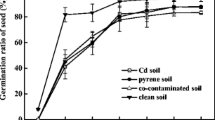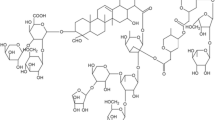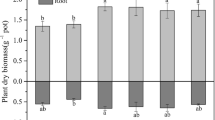Abstract
Tea saponin (TS), a kind of biodegradable surfactant, was chosen to improve the accessible solubilization of pyrene and cadmium (Cd) in co-contaminated soils cultivated Lolium multiflorum. TS obviously improved the accessibility of pyrene and Cd for L. multiflorum to accelerate the process of accumulation and elimination of the pollutants. The chemical forms of Cd was transformed from Fe-Mn oxides and associated to carbonates fractions into exchangeable fractions by adding TS in single Cd and pyrene-Cd contaminated soils. Moreover, the chemical forms of pyrene were transformed from associated fraction into bioaccessible fraction by adding TS in pyrene and pyrene-Cd contaminated soils. In pyrene-Cd contaminated soil, the exchangeable fraction of Cd was hindered in the existence of pyrene, and bioaccessible fraction of pyrene was promoted by the cadmium. Besides, in the process of the pyrene degradation and Cd accumulation, the effect could be improved by the elongation of roots with adding TS, and the microorganism activity was stimulated by TS to accelerate the removal of pollutions. Therefore, Planting L. multiflorum combined with adding TS would be an effective method on the phytoremediation of organics and heavy metals co-contaminated soils.





Similar content being viewed by others
References
Alborés A, Cid B, Gómez E, López E (2000) Comparison between sequential extraction procedures and single extractions for metal partitioning in sewage sludge samples. Analyst 125:1353–1357
Almeida C, Dias A, Mucha A, Bordalo A, Vasconcelos M (2009) Influence of surfactants on the Cu phytoremediation potential of a salt marsh plant. Chemosphere 75:135–140
Baldantoni D, Bellino A, Castiglione S (2014) Different behaviours in phytoremediation capacity of two heavy metal tolerant poplar clones in relation to iron and other trace elements. J Environ Manage 146:94–99
Battin T (1997) Assessment of fluorescein diacetate hydrolysis as a measure of total esterase activity in natural stream sediment biofilms. Sci Total Environ 198:51–60
Brouwer N, Kohen J, Jamie J, Vemulpad S (2006) Modification of the fluorescein diacetate assay for screening of antifungal agents against Candida albicans: comparison with the NCCLS methods. J Microbiol Meth 66:234–241
Gao Y, Shen Q, Ling W, Ren L (2008) Uptake of polycyclic aromatic hydrocarbons by Trifolium pretense L. from water in the presence of a nonionic surfactant. Chemosphere 72:636–643
Gao Y, Zeng Y, Shen Q, Ling W, Han J (2009) Fractionation of polycyclic aromatic hydrocarbon residues in soils. J Hazard Mater 172:897–903
Gao Y, Ling W, Zhu L, Zhao B, Zheng Q (2007) Surfactant-enhanced phytoremediation of soils contaminated with hydrophobic organic contaminants: potential and assessment. Pedosphere 17:409–418
Gillian Adam H (2001) Development of a sensitive and rapid method for the measurement of total microbial activity using fluorescein diacetate (FDA) in a range of soils. Soil Biol Biochem 33:943–951
Gomez-Eyles J, Collins C, Hodson M (2010) Relative proportions of polycyclic aromatic hydrocarbons differ between accumulation bioassays and chemical methods to predict bioavailability. Environ Pollut 158:278–284
Gutierrez-Gines M, Hernandez A, Perez-Leblic M, Pastor J, Vangronsveld J (2014) Phytoremediation of soils co-contaminated by organic compounds and heavy metals: bioassays with Lupinus luteus L. and associated endophytic bacteria. J Environ Manage 143:197–207
Hamdi H, Aoyama I, Jedidi N (2012) Rehabilitation of degraded soils containing aged PAHs based on phytoremediation with alfalfa (Medicago sativa L.). Int Biodeter Biodegr 67:40–47
Iglauer S, Wu Y, Shuler P, Tang Y, Goddard WA (2009) Alkyl polyglycoside surfactant–alcohol cosolvent formulations for improved oil recovery. Colloid Surface A 339:48–59
Jelusic M, Lestan D (2015) Remediation and reclamation of soils heavily contaminated with toxic metals as a substrate for greening with ornamental plants and grasses. Chemosphere 138:1001–7, doi.org/10.1016/j.chemosphere.2014.12.047
Liu F, Wang C, Liu X, Liang X, Wang Q (2013) Effects of Alkyl Polyglucoside (APG) on phytoremediation of PAH-contaminated soil by an aquatic plant in the Yangtze Estuarine Wetland. Water Air Soil Pollut 224:1633–1643
Liu J, Zhou Q, Wang S, Sun T (2009) Cadmium tolerance and accumulation of Althaea rosea Cav. and its potential as a hyperaccumulator under chemical enhancement. Environ Monit Assess 149:419–427
Luo L, Zhang S, Christie P (2010) New insights into the influence of heavy metals on phenanthrene sorption in soils. Environ Sci Technol 44:7846–7851
Ma B, Wang J, Xu M, He Y, Wang H, Wu L, Xu J (2012) Evaluation of dissipation gradients of polycyclic aromatic hydrocarbons in rice rhizosphere utilizing a sequential extraction procedure. Environ Pollut 162:413–421
Momin S, Yeole P (2011) Comparative study of effect of surfactant-polymer interactions on properties of Alkyl Polyglucosides and Alpha Olefin Sulphonate. J Surfactants Deterg 15:291–298
Ortega-Calvo J, Tejeda-Agredano M, Jimenez-Sanchez C, Congiu E, Sungthong R, Niqui-Arroyo J, Cantos M (2013) Is it possible to increase bioavailability but not environmental risk of PAHs in bioremediation? J Hazard Mater 261:733–745
Rinaldi M, Domingos M, Dias A, Esposito J, Pagliuso J (2012) Leaves of Lolium multiflorum ‘Lema’ and tropical tree species as biomonitors of polycyclic aromatic hydrocarbons. Ecotox Environ Safe 79:139–147
Rodriguez J, Pignata M, Fangmeier A, Klumpp A (2010) Accumulation of polycyclic aromatic hydrocarbons and trace elements in the bioindicator plants Tillandsia capillar is and Lolium multiflorum exposed at PM10 monitoring stations in Stuttgart (Germany). Chemosphere 80:208–215
Sun Y, Zhou Q, Xu Y, Wang L, Liang X (2011) Phytoremediation for co-contaminated soils of benzo[a]pyrene (B[a]P) and heavy metals using ornamental plant Tagetes patula. J Hazard Mater 186:2075–2082
Tang S, Bai J, Yin H, Ye J, Peng H, Liu Z, Dang Z (2014) Tea saponin enhanced biodegradation of decabromodiphenyl ether by Brevibacillus brevis. Chemosphere 114:255–261
Trasar-Cepeda C, Leiro's M, Gil-Sotres F (2008) Hydrolytic enzyme activities in agricultural and forest soils Some implications for their use as indicators of soil quality. Soil Biol Biochem 40:2146–2155
Urum K, Pekdemir T (2004) Evaluation of biosurfactants for crude oil contaminated soil washing. Chemosphere 57:1139–1150
Wang G, Zhou Y, Wang X, Chai X, Huang L, Deng N (2010) Simultaneous removal of phenanthrene and lead from artificially contaminated soils with glycine-beta-cyclodextrin. J Hazard Mater 184:690–695
Wang Q, Liu X, Wang C, Zhang X, Li H, Chen T, Hou Y, Chen X, Liang X (2015) Solubilization effect of surfactants on morphological transformation of cadmium and pyrene in co-contaminated soils. Water Air Soil Pollut 226:147–156
Wei J, Liu X, Wang Q, Wang C, Chen X, Li H (2014) Effect of rhizodeposition on pyrene bioaccessibility and microbial structure in pyrene and pyrene-lead polluted soil. Chemosphere 97:92–97
Xia H, Chi X, Yan Z, Cheng W (2009) Enhancing plant uptake of polychlorinated biphenyls and cadmium using tea saponin. Bioresource Technol 100:4649–4653
Zhou W, Yang J, Lou L, Zhu L (2011) Solubilization properties of polycyclic aromatic hydrocarbons by saponin, a plant-derived biosurfactant. Environ Pollut 159:1198–1204
Acknowledgements
The work was funded by the National Natural Science Foundation of China (No. 41373097), Program for Innovative Research Team in University (No.IRT13078).
Author information
Authors and Affiliations
Corresponding author
Ethics declarations
Conflict of interest
The authors declare that they have no competing interests.
Additional information
Responsible editor: Elena Maestri
Rights and permissions
About this article
Cite this article
Wang, Q., Liu, X., Zhang, X. et al. Influence of tea saponin on enhancing accessibility of pyrene and cadmium phytoremediated with Lolium multiflorum in co-contaminated soils. Environ Sci Pollut Res 23, 5705–5711 (2016). https://doi.org/10.1007/s11356-015-5784-9
Received:
Accepted:
Published:
Issue Date:
DOI: https://doi.org/10.1007/s11356-015-5784-9




